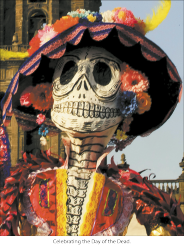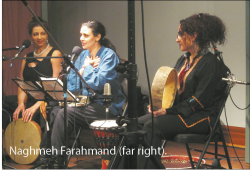 El Dia de los Muertos (The Day of the Dead) has been celebrated by Mexicans for centuries as a time for families to remember and honour the departed. It’s a pre-Columbian custom grafted onto the Christian triduum consisting of All Hallows’ Eve (Halloween to the secular world), All Saints’ Day and All Souls’ Day. Many Mexicans believe that the spirits of the dead dutifully visit their descendants on October 31, returning to their accustomed resting places on November 2. To properly receive their spectral relatives, families make altars and place ofrendas (offerings) of food such as pan de muertos (bread of the dead) baked in shapes of skulls and figures, yellow marigolds known as cempazuchitl, photos, candles, and incense.
El Dia de los Muertos (The Day of the Dead) has been celebrated by Mexicans for centuries as a time for families to remember and honour the departed. It’s a pre-Columbian custom grafted onto the Christian triduum consisting of All Hallows’ Eve (Halloween to the secular world), All Saints’ Day and All Souls’ Day. Many Mexicans believe that the spirits of the dead dutifully visit their descendants on October 31, returning to their accustomed resting places on November 2. To properly receive their spectral relatives, families make altars and place ofrendas (offerings) of food such as pan de muertos (bread of the dead) baked in shapes of skulls and figures, yellow marigolds known as cempazuchitl, photos, candles, and incense.
This practice may sound a touch morbid to some Canadians but to Mexicans death is approached with joy, celebration and playfulness, as well as with mourning. It’s not uncommon for Mexican children to play “funeral” with toys representing coffins and undertakers. The fear of death is transformed through mocking it, as well as by living alongside it, accepting it as a fact of everyday life.
Larry Lake: Day of the Dead rituals have slowly been seeping into our secular Toronto collective consciousness over the past decade or so — see my mention of the Harbourfront events further on in this column. What better time to celebrate influential musicians among us who have recently passed? Larry Lake, the influential Toronto composer, radio broadcaster and record producer, died in September of this year (and was remembered in the October WholeNote by David Jaeger). As he was a friend I’ll call him Larry here, and this is my written mini-ofrenda.
As a composer Larry was best known for his electronic music. Much less well known however is Larry’s support of the early career of the Toronto world music group, Evergreen Club Gamelan (of which I am a member). ECG is Canada’s first performing gamelan group and this season we are marking our 30th anniversary. Larry was an “early adaptor” of the gamelan as a brand new medium for expression among established Canadian composers. “Larry’s support was critical to the fledgling group,” notes Jon Siddall, ECG’s founding artistic director. In the mid-1980s when Siddall commissioned Larry to compose a new work for ECG, the notion of a set of Indonesian gamelan instruments performing contemporary music written and played by Canadians was a brand new — even a radical — proposition. The gamelan ensemble and its music was barely known in the True North. Larry’s open ears, open mind and generous spirit helped the fledgling ECG, among Canada’s first wave of world music groups, to go from strength to strength. In the space of a few years it went on to commission John Cage, as well as dozens of Canadian composers, and to tour internationally.
Larry completed composing his Three Bagatelles for ECG in 1986. Its recording was released on the LP/cassette (later CD) North of Java on the Arjuna label in 1987, the first commercial recording of Canadian gamelan music. I re-auditioned Three Bagatelles recently. I heard a charming three-movement work effectively layering the brash sounds of 1980s electronic music synthesis with the eight-musician acoustic gamelan degung sounds of the ECG. It was in turn declamatory, lyrical and incisively percussive.
Larry’s geniality was often tinged with an endearingly gentle wry sense of humour. When I met him for the first read-through of my suling (bamboo ring flute) part for “Andrew’s Song,” movement two of his Three Bagatelles, I was discouraged by the primitive dot-matrix staff notation printout he presented. I made a comment disparaging what to me seemed an overly simplistic, unchallenging score. Unfazed, Larry gave me some memorable advice: “Treat the notation only as a guide ... go ahead and ‘Eastern it up!’” In other words, play it expressively, where appropriate using idiomatic suling ornaments, articulation, phrasing and dynamic shadings.
From then on whenever I am challenged by a score which appears musically too “square” for its own good I smilingly recall Larry’s challenge to “Eastern it up.” You can hear me heeding Larry’s advice some 27 years ago in the recording of Andrew’s Song, streaming on ECG’s website. When time came to produce a CD from the original LP tracks of North of Java, ECG called Larry. Then in 1994 the group commissioned Larry for Sanft (Soft) another work for pre-recorded electronic sounds and gamelan degung. The collaboration continued with the CD Palace (Artifact Music: 1996) which he co-produced, also streaming on the ECG site.
Through his own compositions in which he dared new cultural mash-ups, his record producing, and his advocacy via his CBC radio music show Two New Hours, Larry did more than introduce generations of listeners to the latest trends in Canadian and international avant-garde concert music. He also introduced them, as I’ve begun to illustrate here, to world music voices which challenged received notions of cultural hierarchies and aesthetic boundaries.
Picks
Sicilian connection: Let’s start this chilly month off with warming southern sounds on November 2 at the Royal Conservatory’s Koerner Hall when two Toronto groups the Vesuvius Ensemble and the Sicilian Jazz Project collaborate. Led by Francesco Pellegrino the Vesuvius Ensemble’s mission is to preserve and stage the music of southern Italy. The Ensemble’s repertoire is anchored in the songs of the Neapolitan region. Moreover they perform on some of the instruments from the region including the tammorra (frame drum), chitarra battente and colascione (plucked lute), and the ciaramella, a shawm. Michael Occhipinti’s Sicilian Jazz Project takes Sicilian folk songs and rhythms and interprets them through the harmonic and improvisatory lens of contemporary North American urban jazz, world music, funk, blues and chamber music. Its stellar lineup starts with the eight-time JUNO Award-nominee Michael Occhipinti on guitar, and continues with seven other leading Toronto jazz musicians.
Harbourfront: As I hinted earlier, on November 9 and 10 Harbourfront Centre hosts what it calls “Toronto’s longest running Day of the Dead festival ... two days of family-friendly programming.” There will be public ofrendas both large and small, plus a wide range of films, mariachi music, songs, dance, food, storytelling, crafting and performances, all with a Dia de los Muertos theme. Some of the music events are listed in The WholeNote pages. For a complete listing of all scheduled events please check the Harbourfront Centre’s website.
York and U of T: York University and the University of Toronto have had world music studio programs running continuously since the early 1970s, I know because I dabbled at them in both places back in the day. Every fall both institutions showcase faculty, students and visiting scholars in public concerts that are well worth exploring. I’ve been invariably delighted by these events and they’re at a price every student can afford: gratis.
November 5 at 12:30pm the York University Department of Music presents a rare demonstration of Azerbaijani mugham by Jeffrey Werbock, a leading expert of this modal music, at the Accolade East Building. The same evening at 7:30 the University of Toronto Faculty of Music presents its “World Music Ensembles Concert” at Walter Hall featuring the Balinese gamelan ensemble, the Klezmer ensemble, and the Japanese taiko ensemble.
November 14 at 12:30 pm York’s Department of Music presents one of Toronto’s premier Korean drum and dance ensembles, the Jeng Yi Korean drum and dance ensemble, at the Accolade East Building.
Back downtown on November 25 at 7:30 in Walter Hall, the U of T Faculty of Music showcases the work of its current world music artists-in-residence, the distinguished Balinese-based performers and scholars Putu Evie Suyadnyani and Vaughan Hatch, and their students in its “World Music Visitor Concert.” The program stages Balinese gamelan and dance including repertoires from royal courts, rituals and entertainments performed on the U of T’s gamelan semar pegulingan (orchestra).
COC Bradshaw: The free noon hour “World Music Series” continues at the Richard Bradshaw Amphitheatre.
 The November 5 concert showcases the bass veena, a new addition to the Hindustani instrumentarium developed by Canadian musician Justin Gray and luthier Les Godfrey. “Monsoon:Synthesis” is the concert’s title evoking a merger of North Indian ragas and original Justin Gray compositions featuring the bass veena and the tabla wizardry of Ed Hanley, with additional percussion and Tibetan singing bowls by Derek Gray.
The November 5 concert showcases the bass veena, a new addition to the Hindustani instrumentarium developed by Canadian musician Justin Gray and luthier Les Godfrey. “Monsoon:Synthesis” is the concert’s title evoking a merger of North Indian ragas and original Justin Gray compositions featuring the bass veena and the tabla wizardry of Ed Hanley, with additional percussion and Tibetan singing bowls by Derek Gray.
November 27 “Balinese Music and Dance: Temple, Court and Village Traditions” takes over Bradshaw Amphitheatre. The event is listed in the “Dance Series,” a fitting designation given that dance and music performance is intimately interrelated in Bali. The U of T’s 20-piece gamelan Dharma Santi alternates with Seka Rat Nadi the gendèr wayang (keyed metallophone quartet). The U of T world music artists-in-residence, Vaughan Hatch and Putu Evie Suyadnyani, are again featured performers.
The last event this month is on November 28. The Shargi Persian Percussion Ensemble performs Unbound. Naghmeh Farahmand, a rare female Iranian percussionist, now a Toronto resident, leads a very unusual all-female percussion group in a program of traditional music from Persia and the Middle East.
Gzowski’s Soldier: November 17 The Music Gallery presents “A Soldier’s Tale” an ambitious multidisciplinary theatre work with both aboriginal and world music elements. Composer, sound designer and musician John Gzowski can certainly be considered among Toronto world music stalwarts, having been active in groups like Maza Meze and Tasa. In this staging of “A Soldier’s Tale” he collaborates with Cree actor, artist, choreographer Michael Greyeyes, video artist Andy Moro and David Sait on guzheng. The work’s narrative explores the soldiering role of First Nations in World War II and Iraq using theatrical dance, enhanced by the contribution of other top Toronto world musicians.
Quick Picks
November 22 and 23 Nagata Shachu stages its “15th Anniversary Concert and CD Release” at the Enwave Theatre, Harbourfront Centre. This viscerally exciting Toronto group, regularly discussed in my column, goes from strength to strength and never disappoints musically.
November 23 at Koerner Hall, the Royal Conservatory and Small World Music present Anoushka Shankar. The star sitarist performs selections from her latest CD, Traces of You, produced by the very successful British Indian musician and composer Nitin Sawhney.
November 27, also at Koerner Hall, the Royal Conservatory, Batuki Music and Small World Music present “Rokia Traoré: Beautiful Africa.” Malian-born Rokia Traoré’s powerhouse voice is the ideal vehicle for her rendition of songs from her most recent album.
Andrew Timar is a Toronto musician and music writer. He can be contacted at worldmusic@thewholenote.com.



